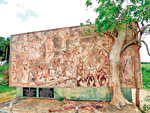Hidden ruins in Hambantota Old Town
View(s):
Martello Tower
Hambantota is one of the districts skirting the Southern Province. Although Hambantota reminds us of the salterns, there are many things to see in the Hambantota District, especially in the Hambantota old town. Hambantota town was hit by the merciless tsunami waves in 2004 and the whole town was destroyed. As a result the ‘new’ town is developing away from the coast. There are some places in the old town which were declared as archaeologically important places by the Archaeological Department.

Andare's Tomb
Martello Tower, Gallows Tree, the Lighthouse and Andare’s Tomb are some of the important places in Hambantota covered by the sand dune of time. The lighthouse was built to provide light to ships during the night, to find their route. There are several lighthouses built around our country. The lighthouse of Hambantota is important among them. It was built in 1878 and the lamp was lighted using gas. It is 88 feet in height and the lamp is at the height of 35 feet. Although it has immense importance it gains less attention.
Martello Tower was built by the British under the guidance of Captain Coper on the tip of the rocky headland alongside the lighthouse overlooking the sea. This was built in order to ease the security. There were about fifty Army and Navy soldiers inside the tower protecting the country from an attack from sea. This is the only Martello Tower in Asia at present. It was restored in 1999 and currently is a fisheries museum.

Hambantota Lighthouse

Gallows Tree
The Gallows Tree in Hambantota is the only gallows tree found in an open area in Sri Lanka today. This was constructed at the back of the then British Army Commander’s official residence, facing the sea. In 1817, the famous Wellassa rebellion was started by farmers in Wellassa. The British controlled it and captured the rural leaders who led the rebellion. Although they shot those rebels, due to lack of bullets, they felt the necessity of a gallows tree. Then a gallows tree was constructed and was used to hang the rebels that joined the Wellassa rebellion and various other criminals.
It was said that the then Governor, Leonard Wolfe had watched the people hanging there from the upper floor of his official residence. This gallows tree too is facing various threats of the weather and will collapse to the ground in the future.
Among the other ruins the old administration building, the old court and several tombs of which identity is unknown, can still be seen in this old Hambantota town.Andare was the royal joker of King Rajadhi Rajasinghe. His name is derived from the Portuguese name ‘Andrew.’ He was famous among both young and old. He was from the southern part of Sri Lanka. During his last days, he was seriously ill and wanted to go back to his home town. He went there as a king wearing a royal uniform and a crown.
On his way, he succumbed to death under a Palu tree at Udamalala village. At that place Andare’s body was buried and the tomb is seen there. A statue was built there showing the manner Andare died stretching his legs and hands.Although these are very important in our history, they have not gained much attention at present. So it is better to pay much attention to them and protect them for posterity.
Nithuli Subasinghe (Grade 9)
Vidura College, Colombo


